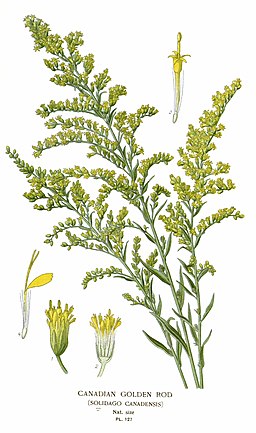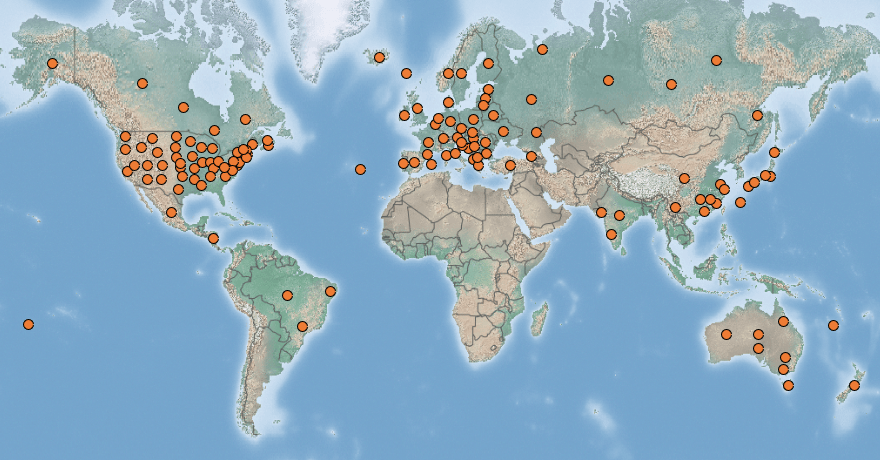 |
Canada goldenrod | Status LU: established. 1st record: LU & ITW <1872. |
 |
Kanadesch Goldrutt | Status Eur.: established. 1st record: 1645.1 |
 |
Verge d’or du Canada | RA: ISEIA: A2, Black List. Harmonia+: 0,39. |
 |
Kanadische Goldrute | Wikipedia:     | Wikispecies: | Wikispecies:  | CABI | CABI |
 |
Canadese guldenroede | Back to the list of neophytes |
Contents
Report the species
→ Report Solidago canadensis to the National Museum of Natural History.
Brief description
 In its native range, the Canada goldenrod is found mainly on forest edges and roadsides, in abandoned fields and other unmanaged areas which it colonises rapidly after abandonment. Where it has been introduced, it occupies the same habitats as in its native range but also occurs in dry meadows of high conservation value and on wetland fringes. S. canadensis is a pioneer and light-demanding species that occurs over a wide range of soil fertility and texture conditions. It can eliminate almost all other plant species; competitive ability is favoured by allelopathic interactions. Once established, the plant may remain dominant for a long period of time and often prevents natural colonisation by woody species (Branquart et al. 2011).
In its native range, the Canada goldenrod is found mainly on forest edges and roadsides, in abandoned fields and other unmanaged areas which it colonises rapidly after abandonment. Where it has been introduced, it occupies the same habitats as in its native range but also occurs in dry meadows of high conservation value and on wetland fringes. S. canadensis is a pioneer and light-demanding species that occurs over a wide range of soil fertility and texture conditions. It can eliminate almost all other plant species; competitive ability is favoured by allelopathic interactions. Once established, the plant may remain dominant for a long period of time and often prevents natural colonisation by woody species (Branquart et al. 2011).
Status and distribution in Luxembourg
Records of Solidago canadensis L. in Luxembourg. Data source: Recorder-Lux, iNaturalist & GBIF, 2025-07-02.
The oldest reference to the species dates from 1872 and states that the species is cultivated for garden decoration, and that it often becomes naturalised in the vicinity of homes and on cemeteries (Fischer 1872: 82). Koltz (1873: 128) lists the species as “cultivated and sometimes subspontaneous near homes and waterways”. Koltz (1874: 30) states that it also becomes naturalised in the vicinity of watercourses. Krombach (1875: 343) states that the species is cultivated and occurs subspontaneously very rarely (RR) in the vicinity of houses. According to Lambinon & Verloove (2012: 703), this naturalised and melliferous species can be found quite rarely (AR-R) in waterfront, forest edges, vacant lots and wastelands.
The first scientific record for Luxembourg that we know of was made by François Léon Lefort (1917-1975) on 17th August 1949 in the Clausen district of Luxembourg City, in neglected gardens and beside paths at the site of the former Mansfeld park (Specimen № 26916, MNHNL 2000-). 174 observations are accessible via the MNHNL-mdata portal (MNHNL, iNaturalist & GBIF 2019).
Risk assessment
ISEIA protocol
A2 (3+2+3+3) = Black List (Ries et al. 2013: 19).
Harmonia+ protocol
Overall risk score 0,39 = (Overall Invasion score 0,71 x Overall Impact score 0,55) (Ries et al. 2020).
 Invasion
Invasion0,55

 Impact
Impact0,39

 Risk
RiskWorldwide distribution
Bibliography
- Branquart, E., S. Vanderhoeven, W. Van Landuyt, F. Van Rossum, F. Verloove, 2011. Harmonia database: Solidago canadensis L. Harmonia version 1.2, Belgian Forum on Invasive Species. URL: http://ias.biodiversity.be [accessed on 2019-10-03]
- CABI, 2014. Solidago canadensis. In: Invasive Species Compendium. Wallingford, UK: CAB International. URL: www.cabi.org/isc [accessed 2020-03-04]
- Fischer, E., 1872. Les plantes subspontanées et naturalisées de la flore du grand-duché de Luxembourg. Publications de l’Institut royal grand-ducal de Luxembourg, section des sciences naturelles et mathématiques XII: 1-115. Imprimerie V. Buck, Luxembourg.
- Koltz, J.-P.-J., 1873. Prodrome de la flore du grand-duché de Luxembourg. Première partie. Plantes phanérogames. Imprimerie V. Buck, Luxembourg. 279 S.
- Koltz, J.-P.-J., 1874. Plantes Phanérogames découvertes dans le Grand-Duché depuis la publication de la Flore luxembourgeoise de Tinant (1836). Recueil des mémoires et des travaux publiés par la Société de botanique du grand-duché de Luxembourg 1: 12-39.
- Krombach, J.-H.-G., 1875. Flore du grand-duché de Luxembourg. Plantes phanérogames. 564 p. Luxembourg, Imprimerie Joris.
- Lambinon J. & F. Verloove, 2012. Nouvelle flore de la Belgique, du grand-duché de Luxembourg, du Nord de la France et des régions voisines. Sixième édition. Avec la collaboration de L. Delvosalle, B. Toussaint, D. Geerinck, I. Hoste, F. Van Rossum, B. Cornier, R. Schumacker, A. Vanderpoorten et H. Vannerom. Jardin botanique national de Belgique, Meise. CXXXIX + 1195 pp. ISBN : 9789072619884.
- MNHNL, 2000-. Solidago canadensis L. in Recorder-Lux, database on the natural heritage of the Grand Duchy of Luxembourg. Musée national d’histoire naturelle, Luxembourg. URL: https://mdata.mnhn.lu [Accessed 2019-09-06]
- MNHNL, iNaturalist & GBIF, 2019. Solidago canadensis L. in MNHNL-mdata, online portal combining species observation from Recorder-Lux, iNaturalist and GBIF. National Museum of Natural History, Luxembourg. URL: https://mdata.mnhn.lu [Accessed 2019-09-06]
- Ries, C. & Y. Krippel, 2021. First records of 56 invasive alien vascular plants in Luxembourg. Bulletin de la Société des naturalistes luxembourgeois 123: 115-127. [PDF 241 KB]
- Ries, C., Y. Krippel & M. Pfeiffenschneider, 2020. Risk assessment after the Harmonia+ protocol of invasive alien vascular plant species in Luxembourg. Bull. Soc. Nat. luxemb. 122: 197-205. [PDF 132 KB]
- Ries, C., Y. Krippel, M. Pfeiffenschneider & S. Schneider, 2013. Environmental impact assessment and black, watch and alert list classification after the ISEIA Protocol of non-native vascular plant species in Luxembourg. Bull. Soc. Nat. luxemb. 114: 15-21. [PDF 652 KB]
Suggested citation of this webpage
Ries, C., M. Pfeiffenschneider & Y. Krippel (Eds.), 2025. Solidago canadensis L. In: neobiota.lu - Invasive Alien Species in Luxembourg. National Museum of Natural History, Luxembourg. URL: https://neobiota.lu/solidago-canadensis/ [Accessed 2025-07-02].
Page content last updated on 2021-03-11. Last proofread by Caroline Grounds on 2019-11-21.
- Cf. CABI 2019.[↩]


